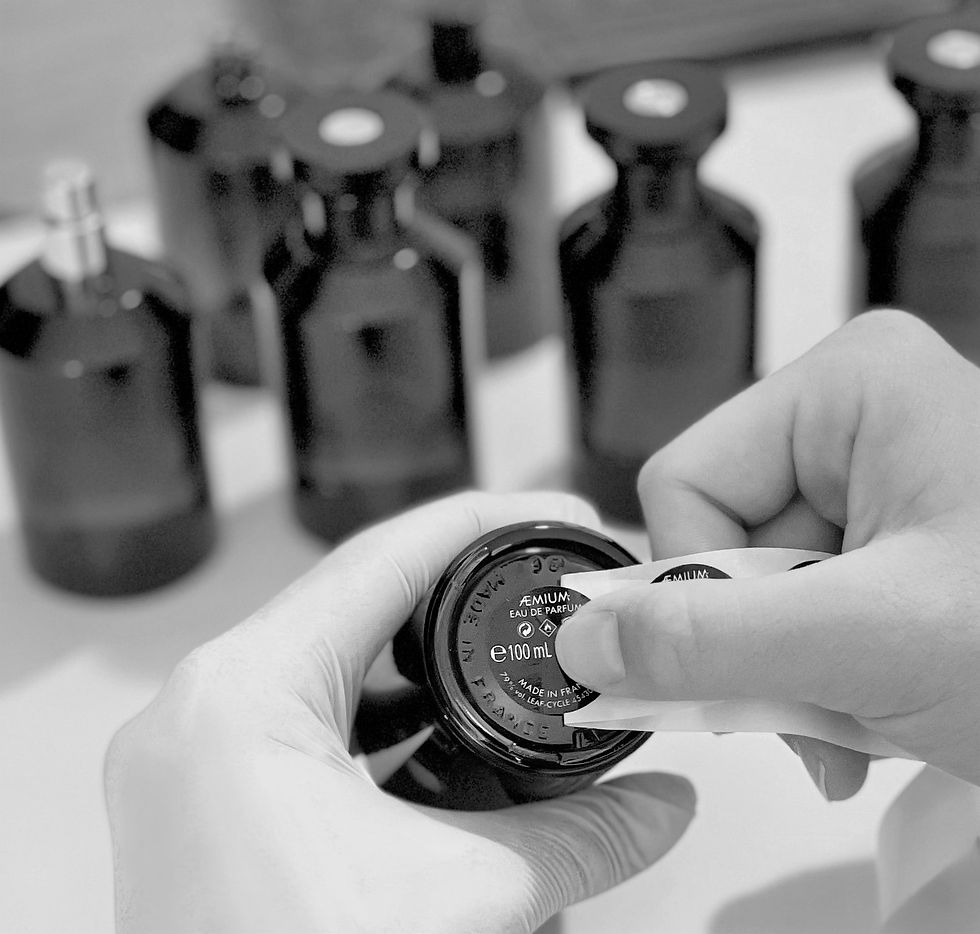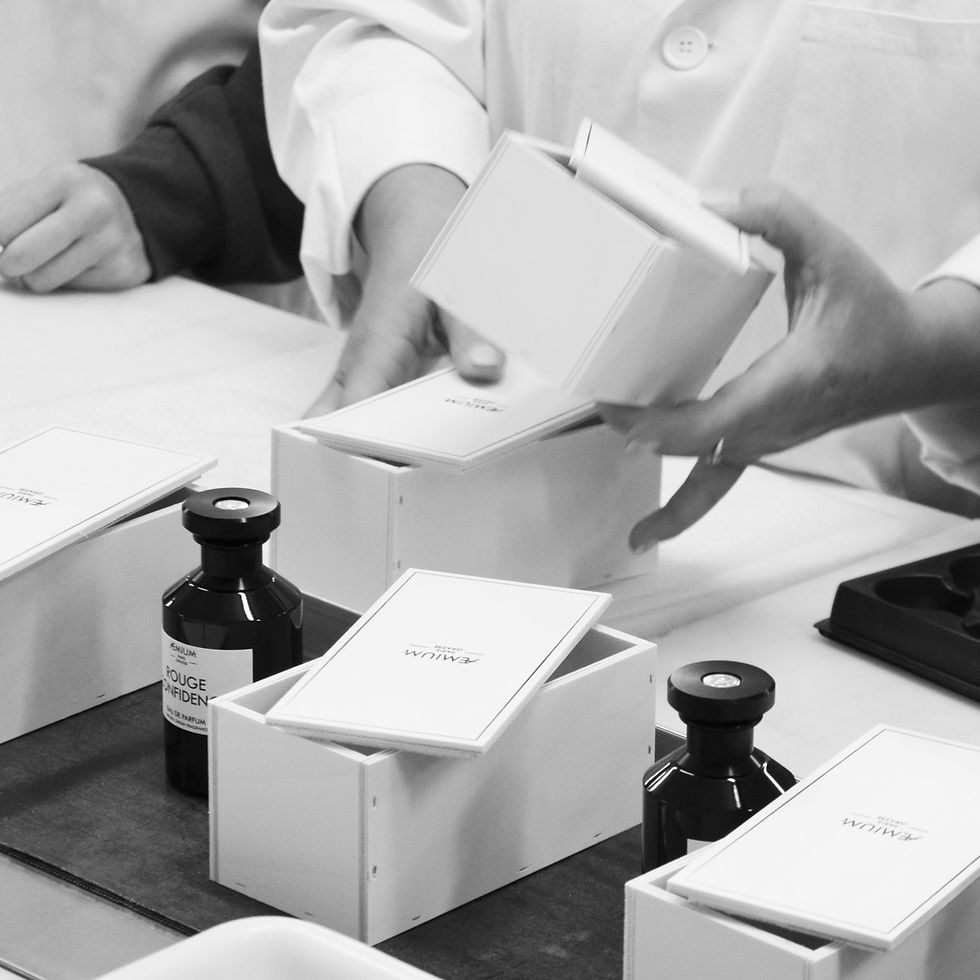~ LUXURY & ECO-DESIGN ~
- Aemium

- Apr 5, 2024
- 4 min read
Updated: Apr 19, 2024
More and more perfume and cosmetics brands are talking about it, but what exactly is it? And how can we detect which brands are sincere and which are discreetly 'greenwashing'? Because it's not just a matter of self-proclaiming that your products are eco-designed: it's not a simple or intuitive process. It requires method and precision.
PART 1: WHAT IS ECO-DESIGN ?
The principle of eco-design is often summed up in the 3 Rs :
REUSE / REDUCE / RECYCLE
The aim is to take action throughout the product life cycle by :

Let's take a closer look at what this means:
1. REDUCE & SIMPLIFY :
By acting on shape & design = consume less raw material / emit less waste during manufacture / the strict minimum necessary to meet technical and functional constraints = no superfluous items
By acting on the number of components = eliminating superfluous elements and grouping together components that fulfil the same function
By acting on transport = optimising volume ratios / maximising the transport of finished products by sea or rail instead of by air / limiting transport distances throughout the product production chain
2. CHOOSING THE RIGHT MATERIALS...
Have a recycled content
Extraction of which requires little fossil energy
Light
Local
No additives
No unnecessary finishing
Not rare, and traceable
3. ENCOURAGING REUSE & UPCYCLING
Implement a rechargeability system
Use long-life components to avoid premature obsolescence
Provide assemblies that can be easily dismantled
Encourage customers to repair products themselves
Finally, provide for the possibility of upcycling* the product (*: transforming the product for another use).
4. ENCOURAGE slow consumption
By limiting energy-consuming products such as electrical and electronic products
By designing the container to deliver the right dose to the user
En assurant un taux de restitution élevé en concevant un contenant qui permet à l’utilisateur de l’utiliser jusqu’au bout
By avoiding waste and extending the product's lifespan
5. ENSURE recyclability :
Only use materials that can be recycled in the country of distribution.
Only use single-material components.
Design assemblies so that the parts can be separated from each other by the end customer.
Eliminate elements that interfere with pack recycling (additives, lacquering, metallisation, plastic labelling).



PARTIE 2: IDENTIFYING BAD PRACTICE
How do you choose a brand that really makes an effort to help the environment, and how do you avoid a brand that tries to deceive the customer? ?
When it comes to fragrances, it's actually quite simple: here are fifteen or so criteria or questions to ask yourself to get a clearer picture.
A/ FIRST IMPRESSIONS ARE OFTEN THE RIGHT ONES!
If the outer packaging is wrapped in cellophane
If the product is oversized
If the perfume feels heavy in your hand, with a large glass weight at the base of the bottle
... then it's best to skip it!

B/AND WHAT ABOUT RECHARGEABILITY?
If the pump won't unscrew, if there's no refill available or if the product can't be easily refilled in a shop near you...
... then it doesn't smell good!
C/ PRODUCT END-OF-LIFE: THINK ABOUT IT BEFORE YOU BUY!
If the product cannot be easily dismantled (pump unscrewed or separated from the bottle)
If the bottle is heavily decorated or metallized
If the cap is heavy and metallized (it is certainly made of galvanized zamac*1 alloy and made on the other side of the world)
If the cap is transparent and thicker than 3mm (it is almost certainly made from Surlyn*2 plastic)
If the cap is made of plastic but is heavy (weighted or loaded with particles)
If the cap is attracted to the bottle (by magnets)
... then, save yourself, because the product will be little or not at all recyclable and uses materials that are a disaster for the environment (magnet, galvanised zamac, surlyn, metallisation...)
D/ FALSE GOOD IDEAS (misleading...)
If the stopper is made of cork or wood with a plastic insert inside.
If the bottle only has a label, but it is made of plastic.
If the product has no cellophane but the box is covered with a plastic film (you try to tear open the cardboard box but you can't because there's a plastic film on the surface...)
If part of the product is made from a multi-material mix that is supposedly upcycled and therefore environmentally friendly (grape seeds, shellfish, hemp...) but the recycling possibilities are not very clear
... it's because the brand hasn't gone all the way with its approach, and is more interested in communicating than actually doing something for the environment.
E/ THE MADE IN FRANCE... NOT SO FRENCH

Of course, there are many other parameters, in particular
sources of supply for components. Ideally, they should be local or French, if not European, but not global, to avoid disastrous carbon footprints. But how can we be sure?
In fact, the Made in France label on the packaging indicates only one thing: the final assembly (manufacture of the perfume itself and packaging) has been done in France. But in no way does it guarantee that the product has been sourced from French suppliers.

While the bottles often come from France, and sometimes Italy or Germany, the stoppers, and in particular the heavy metal or resin caps, can be sourced from much further afield: China, Eastern Europe... The same goes for cardboard boxes: while some are assembled in France, Spain or Italy, many are made in Poland, Tunisia, Portugal or China... where labour is cheap.
Now it's up to you! Look at the fragrances in your bathroom or go into a shop: with this fresh look, you're likely to be surprised!
N.B:
*1 : zamak is a zinc-based alloy to which aluminium, magnesium and copper are bonded.
*2 : Surlyn® is a brand of plastic registered by the chemist Dupont. It is mainly used in the manufacture of stoppers because it imitates glass (transparency and thickness).









Comments